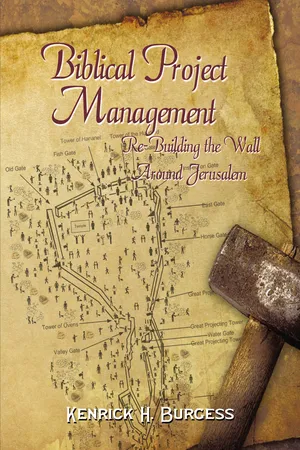
- 296 pages
- English
- ePUB (mobile friendly)
- Available on iOS & Android
About this book
This book is about biblical project management, principles, tools, techniques, and practices used by Nehemiah, a cupbearer to the King of the Persian Empire in the re-building of the wall around Jerusalem and its revitalization. It can be used as a manual for project recovery by project sponsors, owners, leaders, project managers and teams managing projects.
The book has three parts:
Part One deals with the characteristics and definitions of a project and biblical project management, the roles of a project manager, and the importance of stewardship in project management. There is also a brief overview of the Bible, its inspired writers, its impact, legal, financial, and project management systems.
Part Two examines Nehemiah’s project recovery management methodology, and his incredible use of advanced project management tools and techniques are demonstrated by referring to the approaches that he used to re-build the wall and achieve spiritual revival in Jerusalem.
The reader will learn:
- about Jerusalem in the time of Nehemiah
- how to prepare a project background and project definition report
- how to make successful interventions and to present the case for the recovery of a project to owners, sponsors, politicians and public officials
- how to conduct a detailed assessment of a troubled project
- how to do project reviews and document the variances in the scope of works, objectives, milestones, resources, quality, risks and expected deliverables, and to decide on the way forward
- about the capabilities required by the project manager to rescue projects such as courage; leadership; project management skills; technical competencies; project knowledge and understanding; wisdom; solving disputes; assessing the actual scope of works required; and evaluating the cultural, political, economic, social, environmental, and technical issues
- what to include in a final assessment report
- how to prepare the work breakdown structure, precedence network diagram; milestone plan, responsibility matrix, project organization, risk management plan
- how to develop the fifteen plans necessary for construction and control planning
- teamwork strategies, networking, project oversight, monitoring, tracking, construction management, stakeholders’ management and analyses, reasons why projects fail, the role of a project champion, and critical success factors for rescuing troubled projects
- Nehemiah’s project recovery management methodology
- how to revitalize and bring spiritual revival to a city
- how to conduct an ex-post evaluation of a project, and
- how to dedicate a project.
Part Three discusses a) the significance-driven project manager; b) leadership; c) the significance of the walls, towers and gates around Jerusalem; d) how to follow the footsteps of Nehemiah, and e) power tools and power required for project managers.
Frequently asked questions
- Essential is ideal for learners and professionals who enjoy exploring a wide range of subjects. Access the Essential Library with 800,000+ trusted titles and best-sellers across business, personal growth, and the humanities. Includes unlimited reading time and Standard Read Aloud voice.
- Complete: Perfect for advanced learners and researchers needing full, unrestricted access. Unlock 1.4M+ books across hundreds of subjects, including academic and specialized titles. The Complete Plan also includes advanced features like Premium Read Aloud and Research Assistant.
Please note we cannot support devices running on iOS 13 and Android 7 or earlier. Learn more about using the app.
Information
CHAPTER ONE Biblical Project Management
1.0 Introduction
1.01 Biblical Projects: Divinely Recorded




1.02 Biblical Project Management: Divinely Revealed
1.1 The Bible
1.1.1 The Old Testament
1.1.2 The New Testament
1.1.3 The Writers
1.1.4 The Impact
Table of contents
- Cover
- Half-title page
- Title page
- Copyright page
- Dedication
- Epigraph
- Contents
- Foreword One
- Foreword Two
- Preface
- Acknowledgements
- Chapter One: Biblical Project Management
- Chapter Two: Project Background
- Chapter Three: Project Intervention
- Chapter Four: Project Assessment
- Chapter Five: Project Planning
- Chapter Six: Project Construction and Control Planning
- Chapter Seven: Project Construction
- Chapter Eight: Project Operations
- Chapter Nine: Project Dedication
- Chapter Ten: Project Ex-Post Evaluation
- Chapter Eleven: Project Recovery Management Methodology
- Chapter Twelve: The Significance Driven Project Manager
- Chapter Thirteen: Leadership
- Chapter Fourteen: Follow Your Feet
- Chapter Fifteen: The Significance of The Walls, Towers and Gates
- Chapter Sixteen: Power Tools and Power
- Appendix
- List of Tables
- Bibliography
- References
- Index
- Back cover